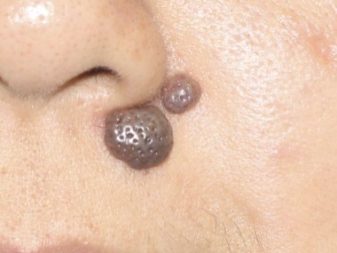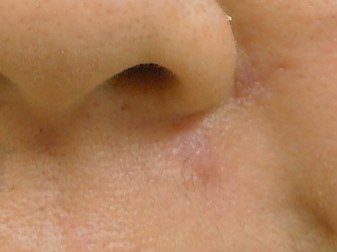Mole Removal Overview
Even though Moles, skin growths or skin lesions are extremely common where most people can expect to have dozens all over the body by adulthood, they can cause some patients to seek out treatment to have them removed.
Moles, or nevi, are simply growths of the skin caused by skin cells growing in a cluster instead of spreading out. Since there are a variety of skin lesions that can take on a variety of colors, shapes, forms, and textures, some people choose to remove them for cosmetic reasons. However, some moles, skin lesions or skin growths can be bothersome, painful, and even dangerous. Dr. Timothy Mountcastle removes these moles, nevi, skin growth for any number of reasons. Most importantly these skin lesions are sent to a dermatopathologist to analyze via pathology to verify that there are not premalignant or malignant cells present within the suspicious lesion.
Mole Removal Before and After*
See More ResultsSurgical Technique
Depending on the depth, size, and location of the mole, mole removal surgery can run from the simple to the complex. Before the surgery, the treatment site will be adequately anesthetized; the surgeon will then use a scalpel to cut into the skin surrounding the mole, as well as a small border of skin around the mole. The skin will be cut (excised) carefully to remove only the minimal amount of tissue necessary. Sutures, or stitches, will be placed in the skin to close up the area.
For moles that are small or not raised or have deep roots, other methods, such as surgical shaving can be used to remove the mole. However, scalpel removal is the typical course of action for moles larger than 2 mm, those with deep roots or those that are suspicious enough for being either premalignant or malignant grossly.
During/After Surgery
These procedures are typically done in the office although occasionally a patient will request it done as an outpatient surgery in a surgery center or a hospital setting if deeper anesthesia is warranted. Each of these facilities mentioned for mole removal is an accredited surgical facility. The treatment site will be numbed beforehand with a local anesthetic. Typically, the surgery takes around 15 – 30 minutes, but it can vary depending on the size, location, depth, and some moles removed. The recovery process is not an extended process and in have a low side effect profile. Most patients require little to no pain medicines after the surgery, but an occasional patient may take a Motrin or Tylenol for a day or two to relieve the typical “dull ache” or discomfort associated with the procedure. After the mole is removed, the patient can expect the treated area to be covered with a steri-strip after the surgery and after the steri-strip is removed silicone-based scar creams are recommended. The surgeon will provide the patient with a scar treatment plan to minimize scarring and maximize benefits from the surgery.
Mole Removal Faqs
Why are moles removed?
Moles are commonly removed for cosmetic reasons, especially when they are large and highly visible, such as on the face. In some cases, a mole can be bothersome to the point that there’s discomfort. However, in some cases, moles can be dangerous and can be pre-cancerous or cancerous and must be removed to pathologically examine the lesion to verify its diagnosis and to maintain a patient’s health.
Does insurance cover the cost of mole removal?
If mole removal is associated with only cosmetic reasons, then insurance won’t cover the cost. If a mole is thought to be premalignant, cancerous, or suspicious, then the insurance carrier will typically cover the procedure. However, Costs can still vary based on deductibles, coinsurance, and copays. It is always best to check with your insurance provider before seeking treatment or call our office with size and description of the lesion, and we can call your insurance company for you to get an out of pocket cost for your procedure.
Will mole removal hurt?
The procedure its self is not painful, the only discomfort you will feel is the initial needle prick when Dr. Mountcastle is injecting the numbing agent. It works so quickly you will stop feeling the needle prick after a few seconds.
How long will removing a mole take?
Typically you are in the office for about 30 minutes from start to finish. First Dr. Mountcastle will clean the area with a cleaning solution and then numb the area. Once the area is fully numbed Dr. Mountcastle will remove the mole and suture the area shut. After that, you will have a small white paper band-aid that will stay on till you come back to get your sutures removed.
Is the mole sent to pathology?
Unless otherwise requested by the patient we send the specimen off to pathology to make sure it is not cancerous. You will get those results back when you come back for the suture removal if the specimen come. If the mole comes back
When can I shower after mole removal?
Dr. Mountcastle recommends you wait 24 hours to get the area wet, he also tells patients to avoid soaking the wound in water as well as being gentle to the area when washing it.
Does removing a mole require stitches?
99% of the time Dr. Mouncastle will suture the wound up. It keeps the wound closed, reduces scarring, and reduced the risk of infection.
When will the stitches come out?
It depends on the area the mole is excised from. Typically for moles removed from the face sutures need to be taken out 5-7 days, no longer than that. For moles removed from the body, he will typically wait 10-14 days.
Can I go swimming/exercise after removing a mole?
Dr. Mountastle asks the patient to wait until the next day to exercise and to avoid any heavy lifting as well as hard running. Swimming is a little different, he does not want patients swimming or submerging the wound in water, especially a pool/ ocean. You can return to swimming once the sutures are out and the wound is completely healed.
Will there be a scar after mole removal?
Yes, there will be a scar. Whenever there is an incision made in the skin there will always be a scar. Dr. Mountcastle specializes in stitching, that is why dermatologist will usually send any mole excision to a plastic surgeon. Since Dr. Mountcastle specializing in stitching, he knows exactly where to place the stitches, how to sew the wound, and what technique to use for that specific wound. Post-op care is also important, you want to make sure you are following directions to avoid any complications. He also recommends scar cream after the wound is completely healed. Anything with silicone in it works best, unfortunately, most over the counter are water based and do not work as well. You also want to make sure you apply SPF 30+ to the area when you are planning on being in the sun. All these things will help reduce the scaring.
Will the mole grow back?
There is no way to know if the mole will or will not come back. Most of the time the mole does not come back but if it does Dr. Mountcastle can always re-excise it.
Can Dr Mountcastle remove more than one mole at a time?
Yes, Dr. Mountcastle can remove up to 6 (depending on the size and area) during one appointment.
Financing Available
Financing InfoRequest An Appointment
Contact Us
